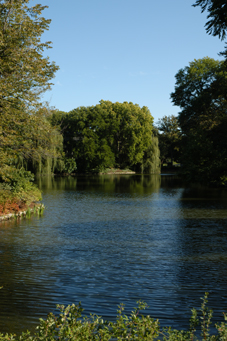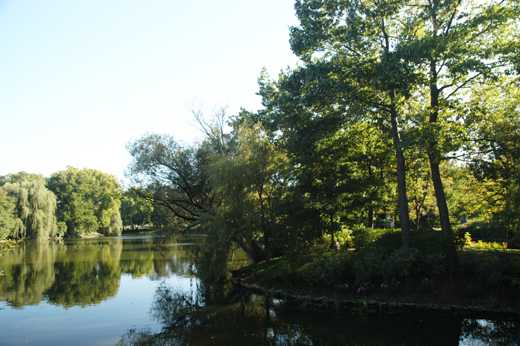Beauty Returns to Burnham Island / Graceland Cemetery, Chicago, Illinois (2010)
Graceland Cemetery’s Burnham Island, Chicago, Illinois

Chicago architect and planner Daniel H. Burnham (1846–1912) is best remembered for something he may not even have said: “Make no little plans.” Whether or not Burnham made this statement—attributed to him by a biographer—it has stuck, possibly because it fit the not-so-little personality and achievements of the man who orchestrated the World’s Columbian Exposition of 1893 and co-authored (with Edward H. Bennett, 1874–1954) the visionary Plan of Chicago of 1909. Burnham’s charisma and connections likely explain why his ashes wound up on a picturesque island in Graceland Cemetery’s Lake Willowmere, designed by his one-time employer, architect William Le Baron Jenney (1832–1907).
In his recently released LALH book Graceland Cemetery: A Design History, author Christopher Vernon notes that a period photograph of a gazebo on the island suggests that Jenney did not intend it as a burial place. Jenney’s Lake Willowmere, a shallow body of water now edged in stones, surrounds the island. Together, they formed “a set piece within Graceland’s landscape composition,” Vernon observes. But Jenney had been dead for five years when, in 1912, Burnham died while traveling abroad and was cremated. The ashes of this larger-than-life figure were interred on the island—as unique a shrine as any of the monuments designed by McKim, Mead & White, Lorado Taft, Daniel Chester French, Louis Sullivan, and other famous architects and sculptors in the “cemetery of architects,” established in 1861.

About five years ago, when Chicago started planning a 2009 centennial celebration of the Plan of Chicago, the Chicago Architecture Foundation chose to focus some of its tours of Graceland Cemetery on “Burnham and His Contemporaries.” The cemetery’s trustees hired Chicago landscape architect Ted Wolff to “spiff up” Burnham Island, which had an eroded shoreline rimmed by unsightly rubble. In places, the shore had crumbled into the lake. “The problem,” Wolff says, “was that we had no historic photographs or other documents to guide a restoration,” until a librarian at the Ryerson and Burnham Libraries of the Art Institute of Chicago directed him to a 1920 biography of Burnham that contained a photograph of the island.
The picture showed a densely planted mound rising from the lake’s surface. A lush design of multitiered trees and shrubs, which Vernon attributes to landscape architect O. C. Simonds (1855–1931), covered the gradual slope to the shore, blurring the line between land and shoulder, with grass mown down to the lake. A canopy of tall trees—ash, honey locust, and willow—still capped the mound, but most of the understory shrubs were gone. Wolff set out to repair the erosion and to replicate Simonds’s planting design as closely as possible; he also persuaded the trustees to add wetland plants along the edges, which would help stabilize the shoreline and attract aquatic wildlife. “No other documentation of Simonds’s plantings has survived, so this is not a true restoration, but it’s in the spirit of the original design,” Wolff explains. “Although Simonds didn’t include wetland plants, they contribute to the aesthetic blurring of the water’s edge.”

After building new underwater basins to retain wetland planting areas, lowering the stone edge on the banks, and restoring the original contour of the slope, Wolff developed a planting plan using previous research on Simonds’s plant palette, including information contributed by the Morton Arboretum, in Lisle, Illinois—itself a Simonds design. “I tried to work within the historical plant palette or with cultivars better suited to current conditions, especially the denser shade under the trees,” he explains. The newly planted shrubs included Anthony Waterer spirea (Spiraea × bumalda ‘Anthony Waterer’), elderberry (Sambucus canadensis), and alpine currant (Ribes alpinum) including the ‘Green Mound’ cultivar. Along the shoreline are red-twig dogwood (Cornus stolonifera), Iroquois Beauty chokeberry (Aronia melanocarpa ‘Morton’), Hancock dwarf coralberry (Symphoricarpos × chenaultii ‘Hancock’), and dwarf bottlebrush (Fothergilla gardenii).
The wetland plants are rooted in a shallow, underwater stone basin filled with soil, to keep the water at a maximum depth of six inches. In this Wolff planted species from the historic plant palette, including yellow flag iris (Iris pseudocorus), blue flag iris (I. versicolor), pickerel weed (Pontederia cordata), and American water lilies (Nymphaea odorata). Although some of these species can be invasive, “aquatic plants have a low tolerance for depth, and they will stop growing when they hit deeper water,” Wolff says.
Completed in 2007, the plantings have started to achieve the romantic lushness and proportion of the early twentieth century. The wetland plants are attracting fish, turtles, frogs, and a host of water birds. The Plan of Chicago centennial has passed, reviving inspiring quotations ascribed to Burnham, including one that could have served as a motto for the likes of Jenney and Simonds: “Let your watchword be order and your beacon beauty,” he—or someone—said. “Think big.” (Related LALH books: Graceland Cemetery: A Design History; Landscape-Gardening; and Silent City on a Hill: Picturesque Landscapes of Memory and Boston’s Mount Auburn Cemetery.)
—Jane Roy Brown